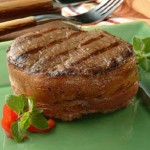It’s the most prized man food, but how many of you actually know how to get the most out of your weekly slab of steak? Or even more so, how many of you even know what steak to buy? Here’s the guide to finding the cut that’s just right for you.
Rump Steak – Best For….Nutrients
Often considered to be the lowliest and most chewy cut, rump is actually lean and a vitamin-rich power food.
Statistics per 100g:
125kcal
4g Fat
22g Protein
—————————————–
Have you ever been chased by a cow? No, I don’t mean being hunted by an angry waitress, I mean by a bovine? If so, I know you’ll appreciate that the animal has an amazing ability to move a ton of flesh and bone extremely quickly. Rump steak itself is derived from the muscles that work the hardest, which pretty much explains it’s super low 4% fat content.
The leanest cut actually is the heart of the rump, and has the most vitamins and enzymes because it has had the most blood flow. Ensure that the muscle fibres are perpendicular to the pan, so that the juices can cook between the muscle fibers, and the steak will be tender. If you are going to cook it well done and ruin it, you might as well just put it in the toaster.
Best Cooked: Rare
Expect To Pay: $15 (Eating Out), $6 (Home Cooking)
—————————————————-
Fillet Steak – Best For….Impressing The Lady
The most expensive and tender cut – perfect for impressing that lady in your life.

Statistics per 100g:
150kcal
7g Fat
21g Protein
—————————
Not every steak is designed to improve your gains, but then again, not every steak is designed to have the same lady-killing cachet as a beautifully prepared fillet steak. It’s maybe not the most flavorsome cut of the animal, but it’s probably the one steak that is most likely to wow over any dinner guest. Fillet is the muscle that opens the cow’s ribs when it breathes, and it does little work so that the muscle itself is very tender.
However, the bad news is that it isn’t so low in fat – with around 7%. When you buy it, it shouldn’t have any silvery-white sinew on it. If you keep the sinew away, it will keep it lean and improve the overall texture. Get your butcher to remove this when you buy your steak, otherwise your steak will have tough, inedible strips going through it, and this is not what you want from a fillet steak.
Fillet, like rump steak, can be butterflied so that the grain of the muscle cooks perpendicular to the pan.
Best Cooked: Rare
Expect To Pay: $30 (Eating Out), $15 (Home cooking)
———————————————
Steak Cooking 101
How To….Cook It
1. You will need a heavy griddle pan that has ridges. Heat it on the stove until it’s hot enough that a few droplets of cold water will take 3-4 seconds to evaporate. Any hotter and the steak will scorch.
2. Brush the steak very gently with a vegetable oil, and place the steak down on the griddle, with it’s most attractive side facing down. Salt the side that is facing upwards generously. Let it cook until the meat starts curling away from the bars of the griddle.
3. Turn the steak over, using a set of blunt tongs. Now cook for an 1/8 of the time that you cooked the first side. It’s rare when the juices are red, medium rare when there’s a hint of red in the juice, brown/clear juices mean it’s medium and a clear juice means it’s a well-done steak.
——————————————–
That concludes part 1 of 2, look out for the second part that’s coming out later on this week.